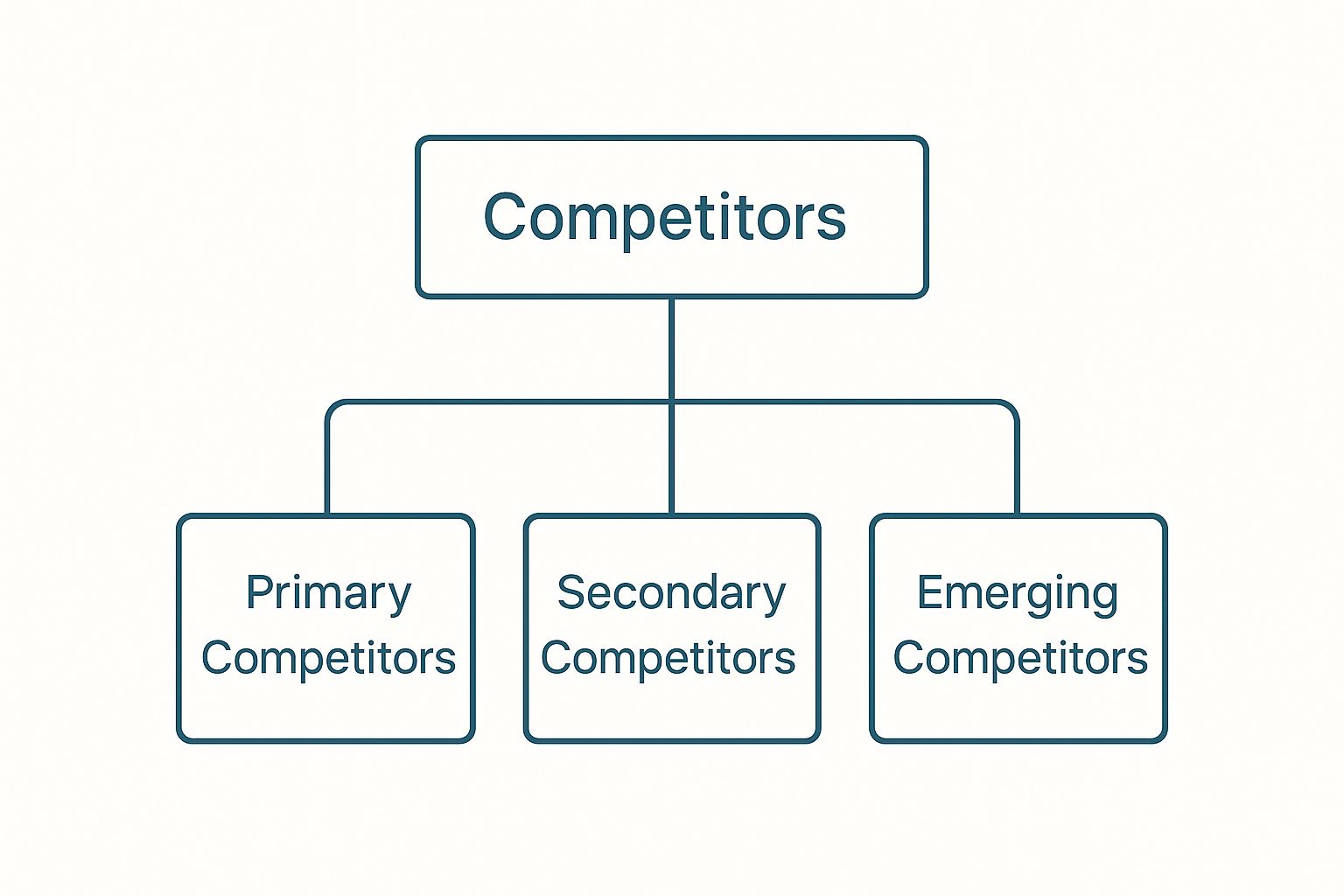
Think of a marketing competitive analysis as your tactical radar, constantly scanning the market for opportunities and threats. It’s the process that takes you from gut-feelings and guesswork to a structured understanding of what your rivals are doing, where they’re falling short, and how you can position your startup to win.
Move Beyond Guesswork in Your Market
As a founder, you're living on a razor's edge where every single decision counts. You simply can't afford to build a strategy on a foundation of assumptions.
A proper marketing competitive analysis isn't some dusty business school exercise; it's a living playbook that informs your every move. Here at BillyBuzz, we don’t get bogged down in 50-page reports. We're all about finding actionable intel, fast.
We’re hunting for those specific gaps that give us an edge. This could mean spotting a content topic a rival completely missed, watching their customer service failures unfold in a Reddit thread, or identifying the exact channels where they're pouring their ad budget. It's about getting granular.

When you approach it this way, your analysis becomes a dynamic tool that directly influences your marketing sprints, product tweaks, and even how your sales team crafts its pitches. It creates a continuous loop of insight and action.
Why This Matters More Than Ever
The demand for this kind of data-driven approach is exploding. The global market research industry—the very foundation of competitive analysis—jumped from $71.5 billion in 2016 to an estimated $140 billion in 2024. That’s a staggering 96% increase.
This tells you everything you need to know: businesses that deeply understand their market and what competitors are doing are the ones that survive and thrive.
Sometimes, the best way to move beyond guesswork is to see what the pros have already found. Leveraging detailed industry analyses like a Golf Course Operation Service Market Research Report can give you a solid baseline understanding of the landscape before you dive into your own intelligence gathering.
Our approach is simple: Find out where the conversation is happening, understand the pain points competitors are creating, and show up with a better solution. It’s less about exhaustive spreadsheets and more about surgical strikes.
This guide is designed to cut through the corporate jargon and share the practical, founder-to-founder approach we've honed over the years. We’ll show you exactly how to build a system that delivers real-time insights you can act on today—not next quarter.
Identify Your True Competitors
Most founders stop digging after listing their top three direct competitors. That’s a critical mistake. A successful marketing competitive analysis means mapping the entire landscape, not just the obvious players. You need to know who else is capturing your audience's attention and budget, even if their product looks nothing like yours.
At BillyBuzz, we don't just track companies that offer social monitoring. We look for anyone solving the same core problem: "How do I find new customers in online communities?" This broadens our view considerably. The real competition isn't just another software; it's a freelancer doing manual searches, a different marketing channel altogether, or a new feature within a larger platform.
This is a key insight many miss. Competition today isn't just about direct rivals anymore. Brands like Nike now find themselves competing with tech companies and digital influencers, not just Adidas. The battle is for customer attention. Understanding this broader view is essential, as detailed in these competitive intelligence trends from the Competitive Intelligence Alliance.
Mapping the Full Competitive Landscape
To avoid getting lost, we categorize everyone into tiers. This helps us focus our energy where it matters most, preventing the classic trap of obsessing over a giant like Salesforce when a nimble startup is quietly stealing market share.
This diagram shows how we visualize the different tiers of competitors we track.

This hierarchy helps us prioritize our data collection and analysis efforts, ensuring we spend the most time on primary threats while keeping an eye on future challengers.
At BillyBuzz, we've found that a tiered approach keeps our analysis focused and actionable. Here’s a look at the system we use internally to make sense of the market.
| Competitor Tier | Who They Are | What We Track | Action Focus |
|---|---|---|---|
| Primary | The direct rivals. They offer a very similar solution to the same audience. | Pricing, features, messaging, customer reviews, content, ad campaigns. | Deep-dive analysis. Look for weaknesses to exploit and strengths to neutralize. |
| Secondary | They solve the same core problem but with a different product or for a different niche. | Overlapping features, target audience shifts, new product announcements. | Monitor for market shifts. Are they moving into our space? Can we learn from their approach? |
| Tertiary | Companies that could become competitors. They have the audience and resources. | Major platform updates, acquisitions, job postings for relevant roles. | Keep on a "watch list." Low-intensity monitoring for early signs of a pivot. |
This tiered system prevents us from getting overwhelmed and ensures our strategic decisions are based on the right information from the right sources.
From there, we get tactical. We use our own tool, BillyBuzz, to set up specific alerts that act as our early-warning system.
- Emerging Competitor Alerts: We monitor keywords like
"new alternative to [Our Competitor]"or"[Our Niche] startup"in communities like r/startups. This often flags new players before they even hit the major tech blogs. - Problem-Based Searches: We track phrases describing the problem we solve, such as
"how to find leads on Reddit"or"tired of manual social selling."This uncovers indirect competitors—companies solving the problem in an entirely different way. - Community Monitoring: We keep a close watch on niche subreddits where our ideal customers hang out. Discussions about
"what tools are you using for X?"are pure gold for discovering competitors we never knew existed.
The goal isn't just to make a list. It's to understand the ecosystem your customer lives in. Who do they see as alternatives? The answer is often surprising and reveals your true competitive threats.
By tracking conversations on platforms like Reddit, you gain unfiltered insights into how customers perceive the entire market. For a deeper dive, check out our guide on how to monitor competitors on social media.
Our Unfiltered Data Collection Playbook
Gathering data for a marketing competitive analysis shouldn't feel like a one-off, soul-crushing project you dread every quarter. It should be a continuous, low-effort hum in the background of your startup. At BillyBuzz, we’ve built a simple, repeatable system to collect raw intelligence without ever getting bogged down in spreadsheets.
We treat online communities as our primary source of truth. Forget filtered case studies and polished testimonials; we go straight to the unfiltered conversations happening every day on platforms like Reddit. This is where you find out what customers really think.
Look at this. It's a typical conversation we'd find in r/SaaS, and it's an absolute goldmine for spotting pain points and competitor mentions.

Threads like this are where the magic happens. They reveal unmet needs and frustrations with existing tools, giving us a direct line of sight into very specific market gaps.
Our Reddit Listening Post
Instead of boiling the ocean, we focus our energy on just a handful of high-signal subreddits. These are our go-to channels for getting a real pulse on the SaaS and startup ecosystem:
- /r/SaaS: This is the best place for direct feedback on B2B software, frank pricing discussions, and competitor call-outs.
- /r/startups: Great for spotting emerging competitors before they hit the mainstream and understanding the broader challenges founders are wrestling with.
- /r/Entrepreneur: Here, we catch conversations about growth tactics and tool recommendations from a less technical, more business-focused crowd.
Trying to monitor these channels manually is a recipe for disaster. It's just not possible. Instead, we use our own tool, BillyBuzz, to set up specific alert rules that act as our eyes and ears 24/7. To really scale this, you might also consider a dedicated sales intelligence platform to automate even more of the process.
To give you a peek behind the curtain, here are the actual alert rules we use inside BillyBuzz. This simple setup captures about 90% of the competitor mentions and industry keywords we truly care about.
BillyBuzz Alert Rules for Competitor Tracking
This table shows the exact queries we've set up. You can use this as a template to start monitoring what people are saying about your competitors and your industry.
| Platform | Keyword Query Example | Alert Frequency | Purpose |
|---|---|---|---|
"competitor_name" OR "alternative to competitor" |
Real-Time | To catch direct mentions and comparisons, allowing for immediate engagement or analysis. | |
"how to find leads on Reddit" AND NOT "our_brand" |
Daily Digest | To identify potential customers expressing a need we solve who aren't yet aware of us. | |
"competitor_name pricing" OR "competitor_name review" |
Real-Time | To monitor sentiment around competitor value propositions and customer satisfaction. | |
"saas marketing tools" |
Weekly Digest | For broader market research, spotting trends and identifying new secondary competitors. |
This automated approach turns data collection from an active, time-consuming task into a passive intelligence stream that lands right in our inbox. It’s incredibly powerful.
Of course, BillyBuzz isn't the only tool out there. If you're looking for more options, we've put together a full guide on the topic: https://www.billybuzz.com/blog/10-ai-tools-for-competitor-analysis-2024.
Engaging and Learning from Conversations
Just gathering the data is only half the battle. When a relevant conversation pops up in our alerts, we have a simple framework ready so we can engage without sounding like a corporate robot.
Our Go-To Response for Pain Points:
"Hey [Username], saw you were struggling with [Pain Point]. A few folks in r/SaaS have had success with [Non-Promotional Advice]. We actually built BillyBuzz to tackle that exact problem by [Specific Feature]. Might be worth a look if you're still stuck."
This approach does two crucial things at once: it provides immediate value to the person asking, and it subtly introduces our solution in a genuinely helpful context. Every one of these interactions is another data point, sharpening our understanding of the market and our competitors' biggest shortcomings.
Turn Raw Data Into a Strategic Advantage
The data you've gathered is just a pile of raw material. The real magic in a marketing competitive analysis happens when you start connecting the dots—turning all that noise into clear, strategic signals. You're looking for the story hidden within the numbers and comments, a story that tells you exactly where to attack.
This isn’t about building a 50-slide deck or getting lost in endless spreadsheets. The whole point is to walk away with a handful of high-impact insights you can act on immediately. At BillyBuzz, we don't do data overload. Our entire process is built to answer one simple question: "What's the one thing we learned that we can use to win this week?"
It’s a founder-to-founder mindset. You have to learn how to spot patterns in scattered customer complaints about a competitor. You need to see the high-value keyword cluster they rank for that you've completely missed. You have to deconstruct the exact value proposition in their best-performing ads. Each piece of intel is a potential advantage just waiting to be claimed.
A Practical Marketing SWOT Analysis
Forget the theoretical SWOT you might have learned in a business class. This is a stripped-down version focused purely on marketing and sales execution. It needs to be quick, dirty, and brutally honest.
- Strengths (Theirs): What are they undeniably good at? Maybe it’s a massive email list, a beloved founder with a huge social media following, or an ironclad brand reputation. Your goal here isn't to compete head-on; it's to find a different angle of attack.
- Weaknesses (Theirs): Where are they dropping the ball? Look in the details—slow customer support, buggy features, confusing pricing, or a total lack of community. This is where you strike. Their weakness should directly inform the messaging of your next marketing campaign.
- Opportunities (Yours): Based on their weaknesses, what market gaps can you fill right now? If their users are complaining on Reddit about a missing integration you already have, that’s an immediate opportunity. Seize it.
- Threats (Yours): What strengths do they have that could put you out of business? If they just raised $20 million, that’s a serious threat. You won't outspend them, so you need a plan to be more agile and outsmart them instead.
The most valuable insights often come from their biggest weaknesses. A competitor's angry customer is your best potential lead, because they're already sold on the solution—they're just unhappy with the provider.
From Reddit Thread to Feature Tweak
Let me give you a real-world example from our early days at BillyBuzz. We set up an alert for a primary competitor and stumbled upon a Reddit thread where users were complaining about how noisy and irrelevant their alerts were. They loved the idea of the tool but hated the execution.
One user wrote something like, "I get 50 notifications a day and maybe one is actually a lead." That single comment was a lightning bolt for us.
We immediately realized our value proposition wasn't just "social monitoring," it was "signal, not noise." This insight drove us to prioritize and heavily market our AI relevancy scoring feature. We changed our website copy, our ad headlines, and our sales outreach to hammer this one point home. We didn't just find data; we found our core differentiator in a single Reddit thread.
That’s the power of this process. It connects raw customer feedback directly to your product and marketing strategy. If you're struggling to make sense of your data, you can find some helpful frameworks in our guide on custom visual templates to simplify data overload.
Don't Just Collect Data—Act on It
A competitive analysis is completely useless if it just collects dust in a shared drive. I've seen it happen. Teams spend weeks gathering data, create beautiful presentations, and then... nothing.
The whole point of this exercise is to find an opening and attack it. It should create a living, breathing feedback loop that sharpens your strategy over time. At BillyBuzz, we don't let insights get stale. We turn them into action, fast.
Your hard-won intelligence needs to fuel everything you do—your content calendar, your ad copy, even your sales calls. This isn't a one-off project; it's the engine that powers your growth.

It's really about closing that gap between what you know and what you do. Spot an opportunity, exploit it, measure the results, and then do it all over again.
From A-Ha Moment to Live Campaign
We have a simple but brutally effective process for this. It’s all about moving from an idea to a live initiative without getting bogged down.
- Turn a Complaint into a Headline: Find a Reddit thread where a competitor's customers are ripping them apart for a missing feature? That's not just an insight—it's your next ad headline. We have literally copied and pasted user complaints into ad copy. It’s the most authentic, hard-hitting messaging you'll ever find.
- Turn a Gap into a Content Pillar: Realize your competitor is completely ignoring a specific audience? That's your next blog series. For example, we found a rival was all-in on enterprise clients, so we launched "BillyBuzz for Solo Founders" and immediately started scooping up the people they were neglecting.
- Turn a Weakness into a Sales Angle: Is their customer support infamously slow? Your sales team now has a knockout punch. We give our team specific quotes from forums to use in demos, like, "I saw you were looking at Competitor X. Some folks say they wait days for a response, which is why our average reply time is under an hour."
This direct pipeline from analysis to action is what separates the winners from the companies that just love making spreadsheets.
The goal is to make your competitor's biggest problem the very reason a customer chooses you. Turn their public failures into your best marketing assets.
This kind of targeted messaging works because it hits on a customer's known frustrations. It’s no surprise that by 2025, 56% of marketing leaders plan to actively invest in this kind of personalization. A report by Deloitte Digital highlights how marketing leaders are leveraging personalization because they see it as a critical strategic advantage. Using your analysis to find these pain points is the most direct path to earning customer loyalty.
A Simple Plan to Make It Happen
Good intentions aren't enough. To make sure these ideas actually see the light of day, we use a dead-simple action plan. It just assigns ownership and a deadline.
| Action Item | Insight Source | Owner | Deadline |
|---|---|---|---|
| Launch ad campaign: "Tired of Competitor X's missing feature?" | Reddit Thread | Sarah (Marketing) | Next Friday |
| Write blog series targeting the "Solo Founder" niche | SEO Keyword Gap | Mike (Content) | End of Month |
| Update sales deck with our support response time vs. theirs | Customer Review Site | David (Sales) | This Wednesday |
This basic structure creates accountability. It’s what ensures your marketing competitive analysis leads to real, measurable wins for the business.
Founder FAQs on Competitive Analysis
We get these questions all the time from other founders. Here’s a quick-reference guide to the most common things people ask when they're ready to get serious about a marketing competitive analysis.
How Often Should I Do a Competitive Analysis?
Forget the old-school "once-a-year" corporate mindset. As a founder, you simply can't afford to work with outdated information. The market just moves way too fast.
At BillyBuzz, we've found a continuous, two-tiered process works best.
- Weekly Pulse Check: This is our quick, lightweight review of automated alerts. We're scanning for major competitor news, any new ad campaigns they've launched, or significant shifts in how customers are talking about them on Reddit. It honestly takes maybe 30 minutes every Monday morning over coffee.
- Quarterly Deep Dive: This is when we really roll up our sleeves. We'll re-evaluate our primary competitors' product, pricing, and core messaging. Here, we're hunting for the bigger strategic shifts, not just the daily chatter.
This approach turns analysis into a consistent habit instead of a massive project that drains resources only to become obsolete the moment it's finished.
What Are the Best Free Tools to Get Started?
While paid tools can automate a lot, you can get incredibly far without spending a dime. The most important thing is building the habit first.
- Google Alerts: Set this up for your competitors' brand names and key industry terms. It’s a basic but surprisingly reliable first line of defense.
- Reddit & Niche Forums: Go directly to the source. Find the subreddits and forums in your industry and see what real users are saying. The conversations are unfiltered gold.
- Ubersuggest (Free Version): Use their free tools to grab a quick snapshot of a competitor's top keywords and most valuable backlinks. This gives you a fantastic starting point for your own SEO strategy.
- Manual Social Media Review: Seriously, just spend 15 minutes a week scrolling through their social media pages. Pay attention to their content strategy, engagement rates, and the tone of the comments people leave.
You don't need a massive budget to get started. You just need to be scrappy and consistent. The goal is to build the intelligence-gathering muscle; you can always add paid tools to scale your efforts later on.
My Competitors Are Huge. How Should I Compete?
Whatever you do, don't try to beat them at their own game. If they have a massive ad budget, you will not win a bidding war. If they have a 50-person content team, you will not out-publish them.
Instead, your analysis needs to be laser-focused on finding their weaknesses, which are almost always tied to their size.
Big companies are often slow to react. They tend to have impersonal, ticket-based customer service. They frequently ignore smaller, niche communities because serving them doesn't "scale" in their eyes. These aren't just weaknesses; they are massive opportunities for you.
Your competitive advantage is your agility. Focus on the underserved customer segments they ignore, the long-tail keywords they don't bother trying to rank for, and the online communities where you can build genuine, one-on-one relationships. Speed and personal connection are your superpowers.
Ready to stop guessing and start winning? BillyBuzz gives you the power to find high-intent customers on Reddit before your competitors do. Start your free trial and turn community conversations into your best source of leads.
